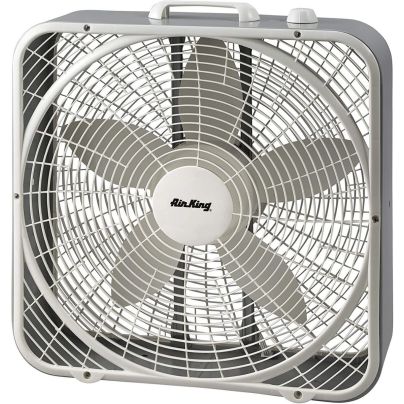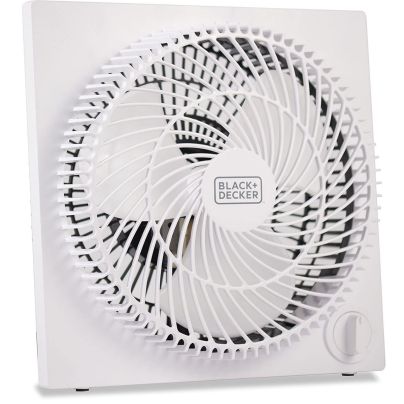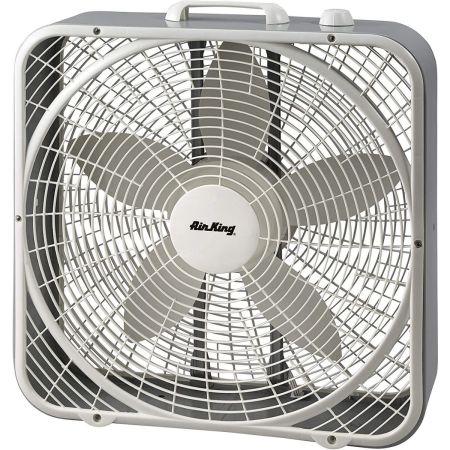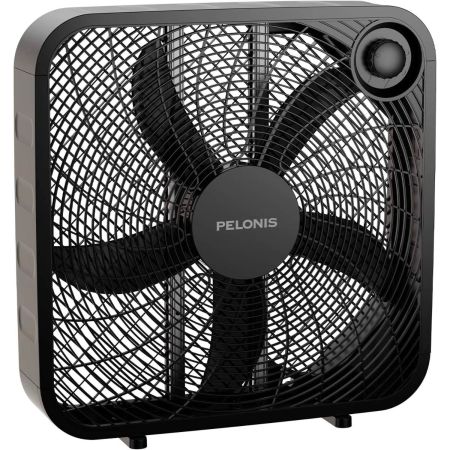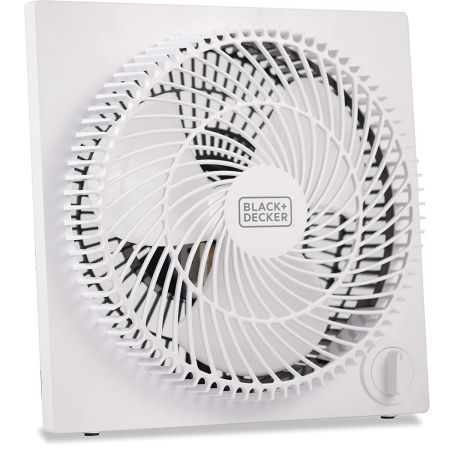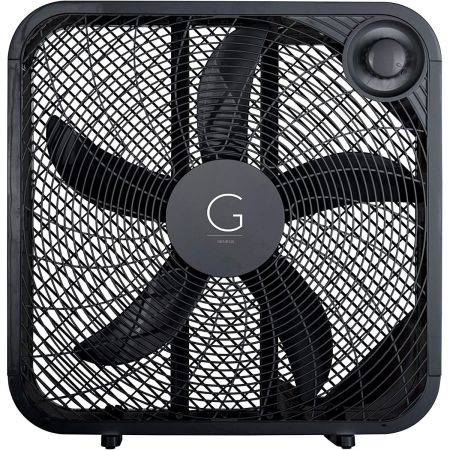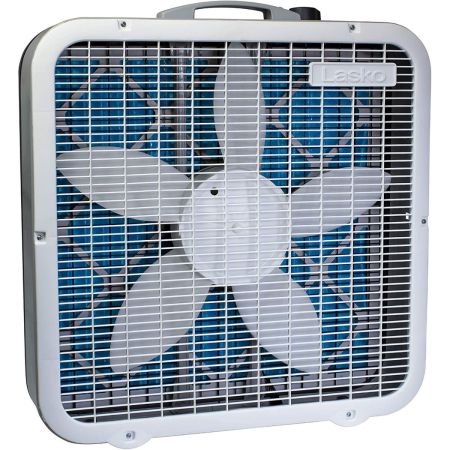
We may earn revenue from the products available on this page and participate in affiliate programs. Learn More ›
During hot and humid months, a good box fan can make a house or garage feel cooler without consuming excessive electricity. However, not all box fans deliver enough airflow to improve a room’s comfort levels. To find the best comfort-inducing options, we recently tested nine box fans over a span of 3 weeks.
Our top pick, the Air King 20″ 3-Speed Commercial-Grade Box Fan, might be a bit noisy, but its power is unmatched. With a wind speed of 12.6 miles per hour (mph) on its highest setting, it kept our stuffy bedroom cool and comfortable all night. We also found other suitable options for those who prefer smaller or quieter fans.
Read on for important considerations, our top picks, advice from experts in the field, and more on the best box fans.
- BEST OVERALL: Air King 20″ 3-Speed Commercial-Grade Box Fan
↓ Jump to Review - RUNNER-UP: Pelonis 20″ 3-Speed Box Fan
↓ Jump to Review - BEST BANG FOR THE BUCK: Black+Decker 9″ Frameless Tabletop Box Fan
↓ Jump to Review - BEST FOR WHITE NOISE: Comfort Zone 20″ 3-Speed Box Fan With Carry Handle
↓ Jump to Review - BEST PERSONAL: Comfort Zone 9″ 3-Speed Portable Box Fan
↓ Jump to Review - BEST FOR LARGE ROOMS: Genesis G20 20″ High-Velocity Box Fan
↓ Jump to Review - BEST ENERGY EFFICIENCY: Utilitech 20″ 3-Speed Box Fan
↓ Jump to Review - BEST COLOR OPTIONS: Lasko 20″ Cool Colors Box Fan
↓ Jump to Review - BEST PURIFYING:Lasko Air Flex 2-in-1 20″ Box Fan and Air Purifier
↓ Jump to Review

How We Tested the Best Box Fans
All box fans were tested in the same locations during the same period of time. Our main test room was a bedroom without air conditioning. The bedroom temperature remained a steady 74 degrees Fahrenheit, which allowed us to evaluate each fan’s cooling ability.
In addition to assessing each fan’s capacity to keep a room comfortable, we measured wind speed using an anemometer, noise levels with a decibel (dB) monitoring app, and energy use on the fan’s highest and lowest settings with the help of an energy meter.
To evaluate portability, we carried each fan up and down our stairs three times, noting how hard or easy it was to do so. We tracked all of our test results in a rubric, where we awarded each fan a score from 0 to 5 based on its ease of assembly, air circulation, portability, noise, and value. Scores were tallied at the end of testing to determine the best overall box fans.
| Testing Stats | |
| Products tested | 9 |
| Time spent testing | 3 weeks |
| Tests performed | 7 |
| Price range | $15 to $60 |
Our Top Picks
The following top-rated products were selected based on extensive research and testing. To ensure thoroughness, we used each box fan for multiple nights and in different scenarios. After testing, we tallied our results and assigned each model an award to make it easy to find the best fan for your needs.
Best Overall
Air King 20" 3-Speed Commercial-Grade Box Fan
Our Ratings: Assembly 5/5; Air Circulation 5/5; Noise 3/5; Portability 4/5; Value 5/5
Product Specs
- Speeds: 3
- Carry handle: Yes
- Dimensions: 22.5 inches tall by 21.4 inches wide by 6.4 inches deep
What We Like
- Provides powerful airflow, making stuffy rooms more comfortable
- Quality steel body with impact-resistant plastic grills
- 6-foot power cord
What We Don’t Like
- Noise may drown out nearby conversations
We spent 3 weeks testing box fans, and none compared to the power and air circulation of the Air King. When placed in a stuffy bedroom, it instantly made the space feel more comfortable. According to our tests, this fan delivered an impressive 12.6 mph wind gust on its highest setting. Even on its lowest setting, it provided more circulation than some of the other models’ highest settings.
Unfortunately, with the powerful airspeed came a lot of noise. The Air King was the loudest of all the fans we tested, ranging from 74 to 77 dB when measured from 2 feet away. We had a hard time carrying on conversations or enjoying a TV show when this fan ran in the background. However, it generated a great amount of white noise, making it easy to fall asleep.
We liked that we could toggle between three speeds, and the carry handle made it easy to transport up and down the stairs. When tested with an energy meter, the Air King consumed between 56 and 80 watts (W) of power. This is one of our favorite fans for the summer. We’d recommend it to those looking for a bedroom fan, but it would also work well in a home gym, garage, shop, or commercial space.
Get the Air King box fan at Amazon or Walmart.
Runner-up
Pelonis 20" 3-Speed Box Fan
Our Ratings: Assembly 5/5; Air Circulation 3.8/5; Noise 3.5/5; Portability 4/5; Value 3.5/5
Product Specs
- Speeds: 3
- Carry handle: Yes
- Dimensions: 21.3 inches tall by 20.6 inches wide by 5.6 inches deep
What We Like
- Lightweight design and carry handle for easy portability
- High-power fan provides ample air circulation
- Aesthetically pleasing with its sleek black design
What We Don’t Like
- Noisy at its highest speed
The Pelonis box fan is a modestly priced option with three speeds, a sleek black design, and a front-facing dial. It is lightweight and has carry handles built into the top corner. We carried this fan back and forth from our home to our shop with little effort.
At its highest setting, the Pelonis delivers powerful airflow that effectively cools down a stuffy room and can help keep you cool without air conditioning. The most noticeable con was the noise level. The Pelonis was loud on its highest setting—we had to lower it to have conversations without shouting.
A standout feature was the recessed cord storage. Most box fan cords look messy when not in use, so we appreciated the ability to keep the power cord tidy and hidden. The fan came with stabilizing feet, a feature often found in higher-end models. We could turn in the feet to use this as a window box fan and turn them back out to put it on the floor.
Get the Pelonis box fan at Amazon.
Best Bang for the Buck
Black+Decker 9" Frameless Tabletop Box Fan
Our Ratings: Assembly 5/5; Air Circulation 3.5/5; Noise 5/5; Portability 5/5; Value 4.5/5
Product Specs
- Speeds: 3
- Carry handle: No
- Dimensions: 11 inches tall by 11 inches wide by 4 inches deep
What We Like
- Produces significant air gusts for its size
- Quiet even on its highest setting
- Unique frameless design
What We Don’t Like
- Not suited for cooling large spaces, like bedrooms
Don’t let this fan’s small stature fool you: Standing 11 inches tall, this box fan from Black+Decker delivers impressive airflow. It features a unique frameless design with a front-facing dial and a compact size that’s well suited for use as a desk fan. On its highest setting, it generates wind speeds up to 11.6 mph, which can make you feel more comfortable as you work or sleep.
This cooling fan is also pretty quiet, with a decibel range of 45 to 50. Even at its highest setting, carrying on conversations and watching TV was easy. According to our energy usage tests, the Black+Decker is an energy efficient choice, consuming about 29 to 41W of power.
Since this model is small, it won’t work in every situation. Though it delivers impressive wind gusts for its size, its 9-inch fan blades limit the amount of air it can circulate. We also couldn’t find any way to remove the casing to clean the blades. Overall, the modern design, portability, and power make this one of the best fans for the office or a bedside table, but its smaller size and shorter cord limit its versatility.
Get the Black+Decker box fan at Amazon, The Home Depot, or Wayfair.
Best For White Noise
Comfort Zone 20" 3-Speed Box Fan With Carry Handle
Our Ratings: Assembly 5/5; Air Circulation 3.5/5; Noise 3.5/5; Portability 5/5; Value 3/5
Product Specs
- Speeds: 3
- Carry handle: Yes
- Dimensions: 22.1 inches tall by 20.9 inches wide by 5.1 inches deep
What We Like
- 3 speeds allow user to adapt to environment
- Lightweight design for portability
- Front grill is removable to clean fan blades
What We Don’t Like
- One of the stabilizing legs broke during assembly
- Short power cord
The Comfort Zone 20-inch fan wasn’t the loudest model we tested, but it came close. When measured from 2 feet away, it produced sound levels ranging from 64 to 68 dB, providing white background noise. We found the fan’s moderately high noise levels to be one of the easiest to fall asleep to. It also produced adequate airflow that made our bedroom feel more comfortable.
We liked the fan’s modern black look and lightweight design. It also came with stabilizing feet to help prevent the fan from moving around while powered on. However, one of them broke during installation. Fortunately, even without the stabilizing feet, we didn’t notice much movement when the fan was powered on high.
Our energy meter tests show that the Comfort Zone used between 68.1 and 83.6W of power. Its top-mounted dial with three speeds was easy to adjust, and the grill is removable via screws for access and cleaning of the fan blades. The power cord was a little short for our liking, and in some setups, an extension cord may be necessary to situate the floor fan where needed.
Get the Comfort Zone 20″ box fan at Amazon or Walmart.
Best Personal
Comfort Zone 9" 3-Speed Portable Box Fan
Our Ratings: Assembly 5/5; Air Circulation 3/5; Noise 5/5; Portability 5/5; Value 4/5
Product Specs
- Speeds: 3
- Carry handle: No
- Dimensions: 11.3 inches tall by 10.7 inches wide by 5.1 inches deep
What We Like
- Ideal size for use as a personal fan
- Quiet box fan on its low and medium settings
- Compact size for desks, nightstands, and small tables
What We Don’t Like
- Not powerful enough to cool down large spaces
Small box fans are ideal for placing on a desk or bedside table, and the Comfort Zone 9-inch fan is one of the best options in this size range. It’s quiet and delivers just the right amount of airflow to cool you off without blowing important papers off your table or desk. According to our energy meter tests, it’s also energy efficient, consuming 16.5 to 26.9W of power.
The Comfort Zone is a quiet fan with three speeds: low, medium, and high. On high, it registered 49 dB of sound, which provided some white noise but was quiet enough to talk over. On medium and low, it was nearly silent. Despite its lack of a carry handle, the Comfort Zone’s compact design makes it easy to pick up and transport without issue.
At its top speed, the Comfort Zone produced wind gusts of up to 5.8 mph, which was much lower than the 20-inch box fans we tested. The airflow was powerful enough to keep one person comfortable. However, the 9-inch blade size means this fan isn’t equipped for whole-room cooling. Even though it’s stationary, this fan can keep you as cool as comparable small oscillating fan models. The Comfort Zone is available in white and black and at a budget-friendly price point.
Get the Comfort Zone 9″ box fan at Amazon.
Best For Large Rooms
Genesis G20 20" High-Velocity Box Fan
Our Ratings: Assembly 5/5; Air Circulation 3/5; Noise 3/5; Portability 4/5; Value 4.5/5
Product Specs
- Speeds: 3
- Carry handle: Yes
- Dimensions: 20 inches tall by 20 inches wide by 4.5 inches deep
What We Like
- 3 fan speeds suit a wide range of needs
- Modern design with a front-facing dial
- Lightweight and portable
What We Don’t Like
- Loud on highest setting
- Shows dust easily; grill isn’t removable for cleaning
The Genesis G20 offers a sleek design with two carrying handles nestled in its top corner. It features a copper motor to promote longevity and high velocity. The fan felt lightweight and was easy to carry around the house, and the stabilizing feet enabled it to rest on any flat surface without wobbling. The front-facing dial also made it easy to adjust when propped in the window.
The Genesis’s three speeds met varying needs, and on its highest setting, this box fan produced enough airflow to help keep a single room comfortable. It also worked well as an air cooler electric fan to circulate the air from AC units. Unfortunately, it didn’t have a removable grill. The black design showed more dust than light colors, but without being able to access the blades, all we could do was clean the outside.
The Genesis produced moderate noise on the low and medium settings. However, it was pretty loud on its highest setting. While this might be helpful for some to fall asleep to, the sound level wasn’t conducive to holding conversations or watching TV. While the noise level will be a deterrent for some, it’s a solid option for large rooms.
Get the Genesis box fan at Amazon, The Home Depot (white), or Walmart (white).
Best Energy Efficiency
Utilitech 20" 3-Speed Box Fan
Our Ratings: Assembly 5/5; Air Circulation 3.5/5; Noise 3/5; Portability 4/5; Value 4.5/5
Product Specs
- Speeds: 3
- Carry handle: Yes
- Dimensions: 21 inches tall by 22 inches wide by 4.1 inches deep
What We Like
- Affordable and attractive
- Has 3 speeds and a front-facing dial
- Most energy efficient of the larger models tested
What We Don’t Like
- Too loud to watch TV on the highest setting
The Utilitech box fan offers three speeds and a sleek, modern design with a recessed carry handle. It’s affordable and available in two colors: white and black. According to our energy meter tests, it was also the most energy-efficient 20-inch box fan we tested, consuming between 43.2 and 54.7W of electricity.
Despite its lightweight design, the Utilitech box window fan delivered impressive performance. Its stabilizing feet ensured it remained steady even when powered at full speed. On its highest setting, it generated wind gusts of up to 11.6 mph, providing air circulation comparable to fans that were twice as expensive.
The Utilitech produced ample white noise, which may be helpful to those who use a box fan to sleep. However, the fan’s loudness on its highest setting was a disturbance when partaking in other activities. Fortunately, the fan’s noise level wasn’t an issue on its lowest setting.
Get the Utilitech box fan at Lowe’s.
Best Color Options
Lasko 20" Cool Colors Box Fan
Our Ratings: Assembly 5/5; Air Circulation 4/5; Noise 3.5/5; Portability 5/5; Value 5/5
Product Specs
- Speeds: 3
- Carry handle: Yes
- Dimensions: 21.8 inches tall by 20.5 inches wide by 4.4 inches deep
What We Like
- Available in 4 colors
- Inexpensive box fan option
- Powerful air circulation with reasonable noise level
What We Don’t Like
- A little wobbly on high power
- Produces a clicking sound when first powered on
While box fans are handy household tools, they aren’t always the most stylish. If you’re tired of a plain white or black fan cramping your style, the Lasko Cool Colors line might suit you. These fans are available in four colors: white, black, light blue, and purple. They feature a 20-inch blade diameter, three speeds, and a lightweight design that’s easy to carry from room to room. The grill is also removable for blade cleaning via six screws that hold it in place.
Despite being one of the most affordable options on our list, this box fan delivered plenty of cooling power, reaching wind gusts of up to 11.6 mph at its highest speed. Its sound level was in the moderate range, producing 59 to 65 dB. This noise level was loud enough to provide some white noise for sleeping yet not terribly disruptive to other activities.
We did notice a couple of minor issues, though. There was a clicking noise when the fan first powered on, but it disappeared after a few seconds. Another con was its shaking. Even though the fan has stabilizing feet, it still wobbled at the fastest speed.
Get the Lasko Cool Colors box fan at Walmart.
Best Purifying
Lasko Air Flex 2-in-1 20" Box Fan and Air Purifier
Our Ratings: Assembly 5/5; Air Circulation 2.5/5; Noise 4.5/5; Design 5/5; Value 4/5
Product Specs
- Speeds: 3
- Carry handle: Yes
- Dimensions: 23.2 inches tall by 21.3 inches wide by 6.4 inches deep
What We Like
- Purifies the air as it runs
- Low noise levels
- 3 speeds offer different levels of cooling power
What We Don’t Like
- Not as powerful air circulation as other box fans
- Shakes on its highest setting
When you need to purify the air, this two-in-one box fan and air purifier will do the job. It features a high-quality steel body construction; three fan speeds; and a removable filter that can clean pollen, smoke, and dust from the air. The Lasko Air Flex comes preassembled and contains one MERV10/42 CADR pleated box fan air filter, so you can immediately use it. Two latches on the back of the fan make it easy to swap out the air filter.
Upon receiving this fan, we immediately put it to work in a stuffy bedroom. While we appreciated the air filter, this fan emitted less of a breeze than some of the other 20-inch models. At its highest setting, it produced wind gusts up to 9.4 mph; at its lowest setting, it emitted gusts up to 5.6 mph. The air circulation was enough to cool down a space, but we preferred a more powerful model to keep our bedroom comfortable.
Those who like a quieter fan will appreciate the Air Flex. While it was a little noisy on its highest setting, it was quiet on the medium and lower settings, allowing us to easily watch TV without being distracted. The biggest con to this model was that it shook when we ran it at the highest speed.
Get the Lasko Air Flex box fan at Amazon, The Home Depot, Walmart, or Menards.
Jump to Our Top Picks
What to Consider When Choosing a Box Fan

When shopping for a box fan to help circulate fresh air within the home, it’s important to find an option that is powerful enough to cool the room and make the space more comfortable. The fan’s noise level, weight, efficiency, and speed settings are also important to consider.
Size
Before deciding on a box fan, it’s important to determine where it will be used to ensure the model you choose is appropriate for the location. For instance, a small 10-inch-square box fan is great for personal use and can be helpful in a small office—on a bookshelf or right on the user’s desk—for direct airflow. However, placing this same fan in a large living room wouldn’t be as effective, as a small fan lacks the power to adequately cool the entire room.
Box fans come in a wide variety of sizes, including small personal fans, standard box fans, and large industrial fans. Personal fans typically measure about 10 inches square, while standard box fans average 20 inches square. Most standard box fans can also be used as window fans. Industrial fans, measuring 24 inches or more, can quickly exceed the size of standard box fans but aren’t a preferred choice for homes because they’re designed for power, not style or noise minimization.
CFM and Speed Settings
A fan’s cooling power is measured by how much air it can move within 1 minute, which is a metric that is expressed in cubic feet per minute (CFM). The average CFM of a standard box fan is 1,100 to 2,500 CFM. Manufacturers use the CFM to quantify the amount of airflow the fan can produce, which is especially important for cooling large rooms, garages, and industrial or commercial spaces.
The CFM is typically provided as the maximum amount of airflow, but many box fans have additional speed settings that can be used for reduced airflow and quiet operation. It’s common to have a low, medium, and high setting, which may also be represented as 1, 2, and 3 on a fan. The low setting is great for simply moving the air in the room without feeling a direct breeze, while medium and high settings will increase the speed and airflow so it can reach people across the room.
Energy Efficiency
“Box fans are a great way to keep a home cool, as long as the temperature outside is lower than the temperature inside, or if you are standing in front of it,” says Hannah Bastawrose, a mechanical and energy engineer and the founder of Itty Bit Better, an energy and sustainability consulting company. Box fans are beneficial to home heating and cooling bills because they don’t use a lot of energy.
On average, box fans use about 50 to 100W per hour, which is an average of $0.011 per hour across the United States. Running the fan for 24 hours, for example, would only cost about $0.26 on an electric bill.
To help reduce energy consumption even further, look for products that meet or exceed Energy Star standards, and remember to turn off the fan when it isn’t needed. While box fans can help anyone within their range, they can be a waste of energy when they are left to run indefinitely, as nobody will benefit from the circulating airflow. If you’re not satisfied with the output of your box fan, you can also consider whole-house fans for energy efficiency and cost savings.
Air Purification
While the main purpose of most box fans is to help keep users cool while the fan circulates the air throughout the room, some box fans can double as air filters. When air is pulled into the fan with a filter, it must be pulled through the filter before it can be pushed back out to the room. This simple addition helps to trap dust, debris, smoke, and other particles that could make it more difficult to breathe.
To be certain that the filter will fit properly, look for a size that matches the fan or find a box fan that is specifically designed to be used with an air filter. Many filters can also be modified for a secure fit. When it’s time to change a filter, some can be washed and reused, though others need to be replaced. Look for air purification standards, like the Minimum Efficiency Reporting Value (MERV), to ensure the filter blocks the specific contaminant that is a common problem in your home.
Noise Level
Historically, box fans were notorious for producing a lot of noise, which was often a major nuisance. However, modern box fans don’t typically have this problem. The average noise level is now comparable to normal conversation, ranging from just 55 to 65 dB. For comparison, whispering is about 30 dB, ambient office noises are around 70 dB, and a noisy restaurant is approximately 80 dB.
Melanie Powers, president of Goodberlet Home Services, which provides HVAC, plumbing, construction, and electrical services in Illinois, advises shoppers to think about sound level before choosing a fan. “While some people prefer that white noise, consider if it is practical to have that noise going in the area you are placing it,” she says. If it’s important for your box fan to operate quietly, check the product details. The information provided by the manufacturer can help determine the average decibel level produced by the fan, enabling you to find a product that is appropriately quiet.
Additional Features
Standard box fans are easy to use and can help circulate air throughout the home, keeping users cool in hot weather. Unlike some tower fans, rotating fans, ceiling fans, or an oscillating fan, they’re stationary. However, some products come with extra features that can make them even easier to use and enjoy. These features include remote controls, removable grills, and front-facing controls.
- Remote controls give the user the ability to turn on the fan and control the fan speed without getting up. This is an excellent feature for people who enjoy sleeping with a fan but who may forget to turn it on before getting comfortable in bed.
- Removable grills may not sound like a good idea because the user can be exposed to the fan blades, which is true in most cases. However, removing the grill when the fan is turned off makes it easier to clean without having to reach through narrow grill bars.
- Front-facing controls are common on personal box fans that tend to sit closer to the user. This makes it easier to operate the fan from a seated position instead of having to get up to see top-mounted controls.
Ease of Cleaning
In order to ensure that the box fan is a beneficial addition to the home, it’s important to keep the fan, the fan blades, and the grill clean. When a fan is clean, the air produced by the fan won’t carry accumulated dust, dirt, and debris that could be inhaled by anyone in the room. Generally, a box fan can be cleaned with a vacuum cleaner and a damp cloth. The vacuum will pull most of the dirt and debris out of the fan, and you can clean the outside frame and grill with the cloth.
However, if the box fan is designed with a removable grill, cleaning becomes much easier. Just unplug the fan or remove the batteries to ensure that it cannot be accidentally turned on. Remove the grill and completely clean the blades, grill, and frame of the fan with a damp cloth.
FAQs
Armed with new knowledge about box fans, you may have some lingering questions about possible features, how to use a box fan, and where to set it up. Before investing in a new box fan, take a look at the following answers to some frequently asked questions.
Even if you’re already using an air conditioner, a box fan is a good idea because it can help circulate cool air more efficiently throughout the room. Using a fan in tandem with air conditioning can minimize the burden on the AC unit, potentially reducing your energy costs.
No, box fans don’t use a lot of electricity. On average, they consume about 50 to 100W per hour, though some larger products may use up to 200W.
Old models of box fans were very loud, but modern products have been designed to be much quieter with an average rating between 55 and 65 dB.
To pull in the cool, fresh air, place the box fan in front of a window and place it facing inward toward the room—or flip the fan around to push hot, stagnant air out of the room. The fan also can be placed in the corner of a room to provide airflow to everyone in the room. Compact products can be set up on your desk for personal use. The choice of placement comes down to where the fan will have the most benefit for the home and the user.
In most cases, it’s safe to run a box fan for extended periods of time. However, dirty, obstructed, or damaged box fans can overheat, creating safety hazards. It’s best to turn off your box fan when you’re not in the room.
Meet the Tester
Katie Barton has over 10 years of experience in product writing, has tested dozens of cleaning products, and has authored hundreds of articles for major media outlets. Her cleaning and organizing advice has been featured on GOBankingRates, Realtor.com, Yahoo!, Cabin Life, and more. She takes an unbiased approach to product testing, using each product multiple times or for several days/weeks to determine efficacy. Her goal is to help readers decide which products are worth their hard-earned money and which fall flat.
Additional research provided by Timothy Dale.
